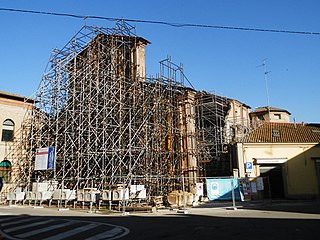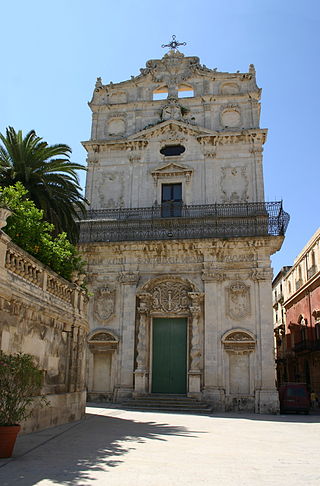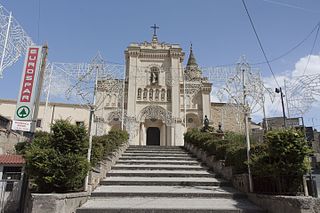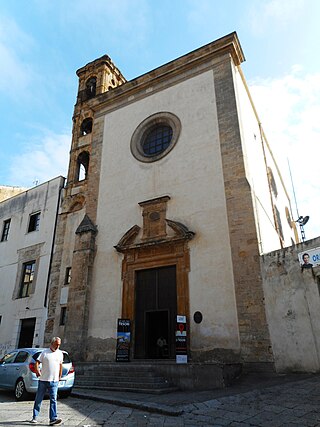
Paola is an Italian comune of 15,408 inhabitants in the province of Cosenza in Calabria.

The Church and Convent of the Girolamini or Gerolamini is a church and ecclesiastical complex in Naples, Italy. It is located directly across from the Cathedral of Naples on via Duomo. The facade is across the homonymous piazza and street from Santa Maria della Colonna. It is one block west of Via Duomo.

San Francesco di Paola is a prominent church located to the west in Piazza del Plebiscito, the main square of Naples, Italy.

San Marco is a religious complex in Florence, Italy. It comprises a church and a convent. The convent, which is now the Museo Nazionale di San Marco, has three claims to fame. During the 15th century it was home to two famous Dominicans, the painter Fra Angelico and the preacher Girolamo Savonarola. Furthermore, the church houses the tomb of Pico Della Mirandola, a Renaissance philosopher and the so called "Father of Humanism."

San Giuseppe is a Baroque architecture, Roman Catholic church building located on Via San Giuseppe, near Piazza Santa Croce, in central Florence, region of Tuscany, Italy, and is one of two churches and an oratory in the city dedicated to St Joseph.

Santa Maria della Stella is a church located on Via Stella 25 in the quartiere of its name in Naples, Italy.

The church of Santa Maria delle Grazie in Brescia is located on at the west end of Via Elia Capriolo, where it intersects with the Via delle Grazie. Built in the 16th century and remodeled in the 17th century, it still retains much of its artwork by major regional artists, including one of its three canvases by Moretto. The other two are now held at the Pinacoteca Tosio Martinengo. The interior is richly decorated in Baroque fashion. Adjacent to the church is the Sanctuary of Santa Maria delle Grazie, a neo-gothic work.

San Francesco di Paola is a Roman Catholic church in Via Garibaldi in the Sestiere of Castello in Venice, Italy.

Santa Croce in Fossabanda is a Renaissance-style Roman Catholic church and monastery in Pisa, region of Tuscany, Italy.

The church dedicated to saint Francis of Assisi, known for centuries as San Francesco Grande is a religious building on the Via San Francesco, previously overlooks the Contra porteghi high in Padua, Italy. Through the efforts of Baldo de Bonafarii and Sibilla de Cetto, the convent of the Friars Minor and the Hospital of Saint Francis, Major, operated until 1798.

Santa Caterina d'Alessandria or Saint Catherine of Alexandria is a Roman Catholic church with a main facade on Piazza Bellini, and a lateral Western facade facing the elaborate Fontana Pretoria, in the historic quarter of Kalsa in the city of Palermo, region of Sicily, Italy. In front of the main facade, across the piazza Bellini, rise the older churches of San Cataldo and Santa Maria dell'Ammiraglio, while across Piazza Pretoria is the Theatine church of San Giuseppe and the entrance to the Quattro Canti. Refurbished over the centuries, the church retains elements and decorations from the Renaissance, Baroque, and late-Baroque (Rococo) eras. This church is distinct from the Oratorio di Santa Caterina found in the Olivella neighborhood.

The Church of Saint Ignatius is a Baroque church of Palermo. It is located in the ancient neighborhood of the Olivella, in the quarter of the Loggia, within the historic centre of Palermo.

The Church of Saint Teresa is a Baroque Roman Catholic church, located on Piazza della Kalsa, facing the Porta de Greci in the ancient quarter of the Kalsa of the city of Palermo, region of Sicily, Italy.

Simone De Wobreck was a 16th-century Flemish painter, whose known works all come from his long period in Sicily.

The church of San Francesco is a church located in Mirandola, in the province of Modena, Italy.

Santa Lucia alla Badia is a baroque-style, Roman Catholic church, now deconsecrated, located on the south corner of the piazza duomo, located to the south of the facade of the Cathedral of Syracuse), located in the island of Ortigia, the historic city center of Siracusa in Sicily, Italy. The church building and adjacent former monastery is now used for special exhibitions and functions.

The church of the Abbey of San Filippo d'Agira is located in Piazza Abbazia #1 in the town of Agira, province of Enna, region of Sicily, Italy. It is also referred to as the Reale Abbazia or royal abbey.

Santa Chiara all'Albergaria refers to a church and former monastery located in piazza Santa Chiara, in the quarter of Albergaria in the city of Palermo, region of Sicily, Italy. The church is located near the busy outdoor Ballarò marketplace.

San Nicola da Tolentino, or more in non-dialect known as the church Saint Niccolò da Tolentino, is a Roman Catholic church located on via Maqueda #157, between via dei Calderai and via Giardinaccio, at the Southwest border of the quarter of Kalsa (Tribunali) of the historic centre of Palermo, region of Sicily, Italy.

Madonna dei Rimedi is a Baroque-style, Roman Catholic Sanctuary-church, established and still affiliated with the Discalced Carmelite order, located on Piazza Indipendenza # 9, in Palermo, region of Sicily, Italy.





















